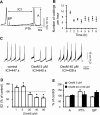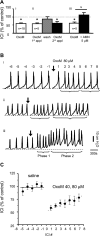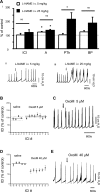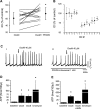Activation of muscarinic receptors in rat bladder sensory pathways alters reflex bladder activity
- PMID: 18287514
- PMCID: PMC2896223
- DOI: 10.1523/JNEUROSCI.4694-07.2008
Activation of muscarinic receptors in rat bladder sensory pathways alters reflex bladder activity
Abstract
Antimuscarinic drugs affect bladder sensory symptoms such as urgency and frequency, presumably by acting on muscarinic acetylcholine receptors (mAChRs) located in bladder sensory pathways including primary afferent nerves and urothelium. However, the expression and the function of these receptors are not well understood. This study investigated the role of mAChRs in bladder sensory pathways in vivo in urethane anesthetized rats. Intravesical administration of the mAChR agonist oxotremorine methiodide (OxoM) elicited concentration-dependent excitatory and inhibitory effects on the frequency of voiding. These effects were blocked by intravesical administration of the mAChR antagonist atropine methyl nitrate (5 microM) and were absent in rats pretreated with capsaicin to desensitize C-fiber afferent nerves. Low concentrations of OxoM (5 microM) decreased voiding frequency by approximately 30%, an effect blunted by inhibiting nitric oxide (NO) synthesis with L-NAME (N(omega)-nitro-L-arginine methyl ester hydrochloride; 5 mg/kg; i.v.). High concentrations of OxoM (40 microM) increased voiding frequency by approximately 45%, an effect blunted by blocking purinergic receptors with PPADS (0.1-1 mM; intravesically). mAChR agonists stimulated release of ATP from cultured urothelial cells. Intravenous administration of OxoM (0.01-5 microg/kg) did not mimic the intravesical effects on voiding frequency. These results suggest that activation of mAChRs located near the luminal surface of the bladder affects voiding functions via mechanisms involving ATP and NO release presumably from the urothelium, that in turn could act on bladder C-fiber afferent nerves to alter their firing properties. These findings suggest that the urothelial-afferent nerve interactions can influence reflex voiding function.
Figures








Similar articles
-
Effects of stimulation of muscarinic receptors on bladder afferent nerves in the in vitro bladder-pelvic afferent nerve preparation of the rat.Brain Res. 2010 Nov 18;1361:43-53. doi: 10.1016/j.brainres.2010.09.018. Epub 2010 Sep 16. Brain Res. 2010. PMID: 20840844 Free PMC article.
-
In vivo paracrine effects of ATP-induced urothelial acetylcholine in the rat urinary bladder.Auton Neurosci. 2020 Sep;227:102689. doi: 10.1016/j.autneu.2020.102689. Epub 2020 May 23. Auton Neurosci. 2020. PMID: 32473532
-
Influence of urothelial or suburothelial cholinergic receptors on bladder reflexes in chronic spinal cord injured cats.Exp Neurol. 2016 Nov;285(Pt B):147-158. doi: 10.1016/j.expneurol.2016.07.005. Epub 2016 Jul 14. Exp Neurol. 2016. PMID: 27423814 Free PMC article.
-
Muscarinic agonists and antagonists: effects on the urinary bladder.Handb Exp Pharmacol. 2012;(208):375-400. doi: 10.1007/978-3-642-23274-9_16. Handb Exp Pharmacol. 2012. PMID: 22222707 Review.
-
Pharmacologic perspective on the physiology of the lower urinary tract.Urology. 2002 Nov;60(5 Suppl 1):13-20; discussion 20-1. doi: 10.1016/s0090-4295(02)01786-7. Urology. 2002. PMID: 12493344 Review.
Cited by
-
Modulation of lower urinary tract smooth muscle contraction and relaxation by the urothelium.Naunyn Schmiedebergs Arch Pharmacol. 2018 Jul;391(7):675-694. doi: 10.1007/s00210-018-1510-8. Epub 2018 May 28. Naunyn Schmiedebergs Arch Pharmacol. 2018. PMID: 29808232 Review.
-
Signalling molecules in the urothelium.Biomed Res Int. 2014;2014:297295. doi: 10.1155/2014/297295. Epub 2014 Aug 10. Biomed Res Int. 2014. PMID: 25177686 Free PMC article. Review.
-
Effects of beta3-adrenergic receptor activation on rat urinary bladder hyperactivity induced by ovariectomy.J Pharmacol Exp Ther. 2009 Sep;330(3):704-17. doi: 10.1124/jpet.109.155010. Epub 2009 Jun 10. J Pharmacol Exp Ther. 2009. PMID: 19515967 Free PMC article.
-
Removal of urothelium affects bladder contractility and release of ATP but not release of NO in rat urinary bladder.BMC Urol. 2010 May 24;10:10. doi: 10.1186/1471-2490-10-10. BMC Urol. 2010. PMID: 20497558 Free PMC article.
-
Methylglyoxal, a Reactive Glucose Metabolite, Induces Bladder Overactivity in Addition to Inflammation in Mice.Front Physiol. 2020 Apr 3;11:290. doi: 10.3389/fphys.2020.00290. eCollection 2020. Front Physiol. 2020. PMID: 32317986 Free PMC article.
References
-
- Bennett BC, Kruse MN, Roppolo JR, Flood HD, Fraser M, de Groat WC. Neural control of urethral outlet activity in vivo: role of nitric oxide. J Urol. 1995;153:2004–2009. - PubMed
-
- Birder LA, Apodaca G, De Groat WC, Kanai AJ. Adrenergic- and capsaicin-evoked nitric oxide release from urothelium and afferent nerves in urinary bladder. Am J Physiol. 1998;275:F226–F229. - PubMed
Publication types
MeSH terms
Substances
Grants and funding
LinkOut - more resources
Full Text Sources
Other Literature Sources
Medical
